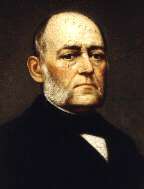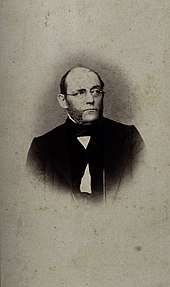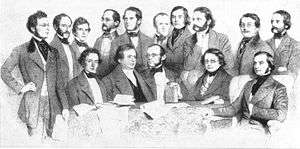Carl von Rokitansky
Baron Carl von Rokitansky (German: Carl Freiherr von Rokitansky, Czech: Karel Rokytanský) (19 February 1804 – 23 July 1878), was a Bohemian physician, pathologist, humanist philosopher and liberal politician.[lower-alpha 1]
Baron Carl von Rokitansky | |
|---|---|
 Baron Carl von Rokitansky | |
| Born | 19 February 1804 |
| Died | 23 July 1878 (aged 74) |
| Alma mater | University of Vienna |
| Scientific career | |
| Fields | Physician pathologist |
| Influenced | Cesare Lombroso |
Medical career

Carl von Rokitansky was born in Hradec Králové (German: Königgrätz), Bohemia. He studied at the Charles University in Prague (1821–1824) and attained a doctorate in medicine on 6 March 1828 at the University of Vienna. In 1830, he became assistant to Johann Wagner,[1] the professor of pathological anatomy, and succeeded him in 1834 as prosector, being at the same time made extraordinary professor. He became a full professor ten years later.[2]
In 1847, to his duties as a teacher, Rokitansky added the onerous office of medico-legal anatomist to the city of Vienna.[2]
In 1863, Rokitansky was appointed by Anton von Schmerling as medical adviser to the Ministry of the Interior, wherein he advised on all routine matters of medical teaching, including patronage.[2]
As a young professor, Rokitansky recognized that the still little noted discipline of pathological anatomy could be of great service to clinical work in the hospital, because it could offer new diagnostic and therapeutic possibilities to the bed-side physician.
Ludwig Freiherr Baron von Türkheim (1777-1846) established the Second Vienna Medical School in 1836. Around Rokitansky's autopsies the school began "one of the most fruitful and brilliant epochs of Viennese medicine".[3] A paradigm shift occurred, led by Rokitansky, Josef Škoda, and Ferdinand von Hebra, moving from the notion of medicine as a branch of natural philosophy, to the more modern notion of it as a science.
Contributions

Rokitansky's name is associated with the following diseases/morphologic features of disease:
- Superior Mesenteric Artery Syndrome
- Müllerian agenesis (aka "Mayer-Rokitansky-Küster-Hauser syndrome")
- Rokitansky's diverticulum
- Rokitansky's triad (pulmonary stenosis)
- Rokitansky-Aschoff sinuses (in the gallbladder)
- Rokitansky-Cushing ulcer
- Rokitansky-Maude Abbott syndrome
- Von Rokitansky's syndrome
- Rokitansky nodule – teratomas
- Congenitally corrected transposition of the great arteries (levo-Transposition of the great arteries) he first described about endometriosis in 1860
Rokitansky also developed a method of autopsy which consisted mainly of in situ dissection. Rokitansky is said "to have supervised 70,000 autopsies, and personally performed over 30,000, averaging two a day, seven days a week, for 45 years".[4]
Philosophical career
Although Rokitansky defended the "materialistic method" in scientific research, he rejected materialism as a philosophical world view. In his commemorative speech on the occasion of the opening of the Institute of Pathological Anatomy at the General Hospital of Vienna, he warned against the abuse of "natural science liberties". Scientists should first regard humans as "conscious and free-willing subjects" and only then follow their urge toward knowledge. The feeling of humanity would be lost if physicians regarded human beings purely as research objects. Thus Rokitansky brought up for the first time the question of ethics in medicine. In another speech about the "solidarity of all animal life", delivered at the Imperial Academy of Sciences, Rokitansky showed his proximity to Arthur Schopenhauer's writings on compassion: "if we [... ] preserve and practice compassion", he explained "we are able to alleviate part of the load of suffering" of patients. Human generosity will be shown by our capability to accept the greatest sufferings by voluntarily renouncing aggression. Those who succeed in this should be our greatest ethical role models.
In 1845, he was elected a foreign member of the Royal Swedish Academy of Sciences. On 17 July 1848 Rokitansky was elected as an effective member of the Imperial Academy of Sciences. In 1866, he became its vice-president and from 1869 until his death in Vienna, Austria-Hungary, on 23 July 1878, its president.[2] Rokitansky felt that this "was the largest honour which I could enjoy".
Political career
_%E2%80%93_Gerd_Hru%C5%A1ka.png)
By way of his leading positions in the most diverse academic and political institutions of the Austrian Empire, Rokitansky helped to shape the era of Austrian high liberalism. He represented liberalism among the educated middle class and strove for "freedom and progress", both to the university reform and to the substantial improvement of health sciences. Rokitansky was several times the dean of the medical school, and, in 1853, the first freely elected rector of the medical congregation of the University of Vienna and president of the Superior Medical Council. From 1850 until his death, he also presided the Physician's Society of Vienna. On 25 November 1867 he was "unexpectedly and unprepared" nominated by Franz Joseph I to the upper house of the Royal Council (German: Reichsrath) in recognition of his public service.[2] Finally, he was elected in 1870 to the presidency of the Anthropological Society.
Family
Two of Rokitansky's sons became professors at Vienna, one of astronomy and another of medicine, while a third gained distinction on the lyric stage,[2] and another as a composer:
- Hans von Rokitansky (1835–1909), became an opera singer.
- Victor von Rokitansky (1836–1896), became a composer.
- Prokop Rokitansky (1843 – 24 August 1928), became a doctor.
Bibliography
His published works include:
- Handbuch der pathologischen Anatomie ("Handbook of pathological anatomy", 3 vols., Vienna: Braumüller und Seidel, 1842–1846; English translation by the Sydenham Society, 4 vols., London, 1845–1852) This is his principal work. It was entirely redone and issued under the title of Lehrbuch der pathologischen Anatomie ("Textbook of pathological anatomy", 3 vols., 1851–1861)
- Die Defecte der Scheidewände des Herzens ("Defects in the septa of the heart", Vienna: W. Braumüller, 1875)
In popular culture
The main character in the film series Mad Max, Max Rockatansky, is named after Carl von Rokitansky. The reason for this bizarre connection is the fact that the director of this film series, George Miller, studied medicine and also made a living as doctor at the time when he was raising funds for his first movie - Mad Max 1.[5]
Notes
Footnotes
Citations
- A History of Endometriosis by Ronald Elmer Batt
- Chisholm 1911, p. 462.
- Intellectual Development of Carl Von Rokitansky
- Stöppler, MD, Melissa Conrad (2015-06-01). "Medically Reviewed by [Jay W. Marks, MD]." MedicineNet, 1 June 2015. Autopsy (Post Mortem Examination, Necropsy). Retrieved from http://www.medicinenet.com/autopsy/page4.htm.
- "11 Fascinating Facts About Mad Max". www.mentalfloss.com. 21 May 2016. Retrieved 12 July 2020.
References

Further reading
- Rumpler, Helmut. Carl Freiherr von Rokitansky. Boehlau Verlag, Vienna. 2006. ISBN 3-205-77205-9

External links
- Carl Freiherr von Rokitansky. WhoNamedIt.
- Carl von Rokitansky at Find a Grave